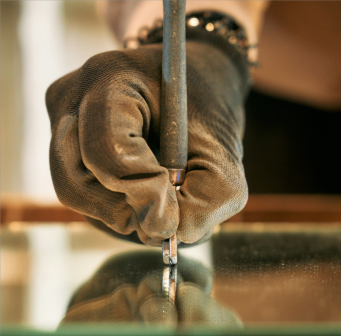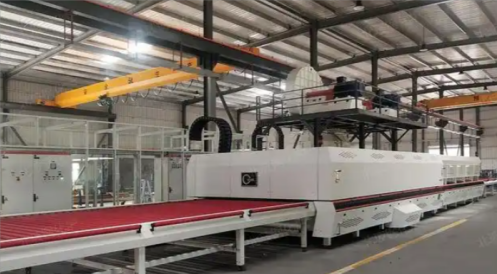News
Production Process of Tempered Glass
Tempered glass is produced by processing and modifying ordinary glass through special techniques. Through scientific pre-treatment, precise heating, rapid quenching, and strict inspection, ordinary glass is transformed into high-performance tempered glass.
Production Process of Tempered Glass: Transformation from Raw Glass to Finished Product
The core of tempered glass production lies in changing the internal stress structure of glass through the "heating-rapid cooling" quenching process. The entire process involves four key steps, each playing a decisive role in the final product quality.
1) Pre-treatment of Raw Glass: Laying the Foundation for Quality
First is the selection of raw glass. Most mainstream tempered glass on the market uses float glass as the raw material. Due to its flat surface and uniform thickness, it ensures stability during subsequent heating and cooling processes, and avoids defects in the finished product caused by poor quality of the raw material.
Subsequently, the float glass is cut into specified sizes according to actual requirements, with the cutting accuracy controlled at the millimeter level. After cutting, a dedicated edge grinding machine is used to polish the edges of the glass to remove sharp edges and corners. This not only prevents injury to personnel during transportation and processing, but more importantly, avoids stress concentration at the edges and reduces the risk of breakage during subsequent heating.
Finally, cleaning and drying are conducted. The glass surface is first rinsed with a high-pressure water gun combined with a neutral cleaning agent to remove impurities such as dust, oil stains, and fingerprints. After cleaning, the moisture on the glass surface is completely dried using a hot air drying system to ensure the glass is in a dry state when entering the heating furnace.

2) Heating Treatment: "Prelude to Transformation" Near the Softening Point
The pre-treated glass is sent into a tempering furnace, where the temperature is precisely controlled between 600°C and 650°C. This temperature range is close to the softening point of glass (approximately 700°C) but does not reach the melting state. It allows the internal structure of the glass to be adjustable while preventing the glass from deforming due to over-softening.
During the heating process, the glass is slowly transported through high-temperature-resistant rollers inside the furnace. The rotation speed of the rollers is adjusted according to the thickness of the glass. Uneven heating will affect the performance of the glass.

3) Rapid Cooling (Quenching Process): Key to Achieving High Strength
Rapid cooling is the key step to endow tempered glass with high strength, as it creates a special stress balance inside the glass through rapid temperature reduction. When the glass is taken out of the heating furnace, it is immediately sent into an air grid device, which rapidly cools the surface temperature of the glass from above 600°C to near room temperature within a few seconds.
In this process, the glass surface first shrinks and solidifies due to rapid cooling, while the internal temperature drops slowly and remains in an expanded state. When the internal part gradually cools and shrinks, it is restricted by the solidified surface layer. Eventually, a uniform compressive stress is formed on the glass surface, and a tensile stress is formed inside.
This balanced structure of "surface compressive stress + internal tensile stress" enables the impact strength of tempered glass to be 3-5 times that of ordinary glass, and the bending strength to be 2-3 times that of ordinary glass.

4) Inspection and Finished Product: Strict Screening to Ensure Quality
Glass that has undergone quenching is not directly turned into a finished product; it still needs to undergo strict quality inspection.
The inspection includes appearance inspection: the glass is irradiated with strong light to check for defects such as bubbles, scratches, stones, and edge chips. National standards clearly specify limits on the number of bubbles and the length of scratches per square meter of tempered glass.
Performance inspection: Impact tests (using a steel ball of specified weight to drop from a specified height to impact the glass) and bending tests (applying pressure on both ends of the glass to test its maximum load-bearing capacity) are conducted to verify whether the strength of the glass meets the standards.
Stress inspection: A stress meter is used to check whether the internal stress distribution of the glass is uniform and whether the stress value meets the requirements.
Qualified tempered glass is packaged according to its size and intended use. Its edges are usually wrapped with EPE foam, and then it is packed in cardboard boxes or wooden crates to prevent damage from collisions during transportation.
It is important to note that once tempered glass is produced, it cannot be further processed such as cutting, drilling, or edge grinding. These operations will destroy its internal stress balance, causing the glass to break instantly. Therefore, all processing requirements must be completed during the raw glass pre-treatment stage.
RELATED NEWS
- Clean Room for Float Glass Production Lines: The Core Guarantee of High-Quality 2025-12-09
- Chinese Float Glass and Laminated Glass Prices Hit Bottom, Seize the Pre-Holiday 2025-11-21
- How to Choose the Right Bathroom Door Glass? 2025-11-10
- How to Accurately Choose the Size of a Tempered Glass Tabletop? 2025-10-31
- Application of Float glass and ultra-clear glass 2025-10-24
CATEGORIES
LATEST NEWS
CONTACT US
Contact: Mark
Phone: 0086-15153264838
E-mail: trade@vidriosglass.com
Whatsapp:0086-15153264838
Add: Jinshi International Square, No. 157,Jinggangshan Road,Qingdao City,Shandong,China
